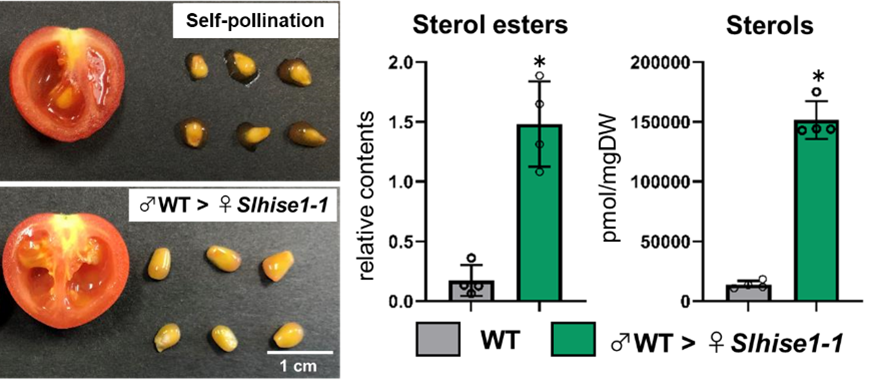Advantages
- It is possible to develop tomato varieties that contain high levels of phytosterols, which inhibit the absorption of cholesterol.
- Phytosterols are also abundant in leaves and stems, so the use of waste plant parts as functional raw materials and the development of other leafy vegetables is expected.
Technology Overview & Background
Plant sterols have a chemical structure like cholesterol and, when ingested by humans, inhibit cholesterol absorption in the lumen of the small intestine, thereby reducing cholesterol in the blood. It is therefore expected to prevent lifestyle-related diseases such as atherosclerosis, myocardial infarction and cerebral infarction, and research is also underway into its action to inhibit colorectal cancer and prostate hypertrophy, and it is expected to attract more attention as a functional ingredient in the future.
Phytosterols are biosynthesised from Acetyl-CoA via the mevalonic acid pathway; HMGR (HMG-CoA reductase) is a reductase that produces mevalonic acid from HMG-CoA. In Arabidopsis, inventors have shown that it is negatively regulated by the HISE1 gene and prevents overproduction and overaccumulation of phytosterols through repression of HMGR expression (https://doi.org/10.1038/s41477-019-0537-2). As the HISE1 gene is well conserved among plant species, a microtom line (Slhise1-1) was created by genome editing to knock out the HISE1 (SIHISE1) gene identified in tomato, and the number and area of fat droplets (LDs) that accumulate phytosterols in the plant body were We found that the number and area of fatty droplets (LDs) accumulating phytosterols in the plant body increased, and that the accumulation of sterol esters (SEs), among phytosterols, increased more than 100-fold in leaves and 10-fold in fruits compared to the wild type.
The Microtom strain (Slhise1-1) produced is expected to be used as a breeding parent to develop new varieties as functional tomatoes with high phytosterol content. As they also accumulate in high amounts in leaves, this technology is also applicable to the development of new varieties of leafy vegetables such as lettuce with modified HISE1 genes.
 |
Data
- The phytosterol content in the leaves and fruits of Slhise1-1 tomato plants was found to be more than 100-fold higher in sterol esters and dolichols in the leaves and 10-fold higher in sterol esters and free sterols in the fruits compared with the wild type.
Principal Investigator & Academic Institution
Dr. Takasi Shimada (Chiba University)
Expectations
- We welcome collaboration with companies wishing to develop new functional tomato varieties using the microtom strain (Slhise1-1) as a breeding parent. Paid MTA of established SIhise1-1 strains is available.
- We also welcome collaborations with companies wishing to apply the strain to leafy vegetables such as lettuce and other crops.
Project No.WL-04782a


